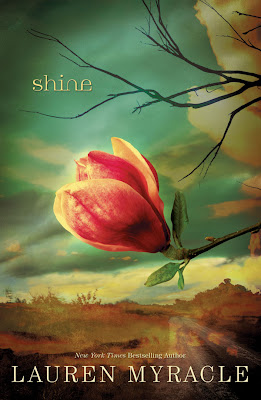Patrick's house was a ghost. Dust coated the windows, the petunias in the flower boxes bowed their heads, and spiderwebs clotted the eaves of the porch. Once I might have marveled at the webs – how delicate they were, how intricate – but today I saw ghastly silk ropes.
Patrick was found left for dead outside the Come 'n' Go where he works, with an anti-gay slur written on his bare chest. When the town sheriff doesn't seem to be inclined to find the real culprit, Cat Robinson, Patrick's former best friend, decides to start her own investigation even if it means knocking on the doors of people she hasn't talked to in years.
I usually don't read a lot of YA novels, mostly because as I'm difficult in my choice of books, I'm afraid they might not suit my reading expectations. So, either Lauren Myracle's novel, Shine (2011), is an exception or I'm actually missing something passing over YA fiction. Obviously, as I'm not an avid reader of this sort of books, I don't spend much time looking for them (usually I just wait for them to magically appear on my shelves).
And I know they say to never judge a book by its cover, but if I found myself reading the synopsis of Shine, it was mainly because I found the cover art amazingly beautiful (it is a nice covert art, right?). But once the book is open, the colorful cover gives way to a dark page featuring a newspaper article. Believe me, there is no light shining through these first gloomy pages.
The good part is that this article enables to introduce us to the main incident in the story: Patrick's aggression. As the story opens, we are left in the hands of sixteen-year-old Cat, who lives in Black Creek, a small and poor town in North Carolina inhabited by conservative and narrow-minded adults, and hopeless teenagers who take drugs in order to escape this messy reality. Cat's life isn't brighter than any other's. She lost her mother when she wasn't even old enough to remember her, and her father lives alone in a trailer in her backyard and overdoes alcohol.
And I know they say to never judge a book by its cover, but if I found myself reading the synopsis of Shine, it was mainly because I found the cover art amazingly beautiful (it is a nice covert art, right?). But once the book is open, the colorful cover gives way to a dark page featuring a newspaper article. Believe me, there is no light shining through these first gloomy pages.
The good part is that this article enables to introduce us to the main incident in the story: Patrick's aggression. As the story opens, we are left in the hands of sixteen-year-old Cat, who lives in Black Creek, a small and poor town in North Carolina inhabited by conservative and narrow-minded adults, and hopeless teenagers who take drugs in order to escape this messy reality. Cat's life isn't brighter than any other's. She lost her mother when she wasn't even old enough to remember her, and her father lives alone in a trailer in her backyard and overdoes alcohol.
I thought the most interesting thing about Myracle's novel is how she manages to intertwine the story of Black Creek's community with the detective plot. After all, the question Cat tries to find the answer to throughout the novel is: who is Patrick's aggressor? As we follow her from house to house in her quest to uncover the person who did it, we are introduced to the town inhabitants. Not only is Myracle's writing style very agreeable, but she handles the multiplicity of voices (and she does know how to reproduce teen slang) to the perfection.
The flashbacks from Cat's memories constitute the core of the novel. They take us back in time and help us understand the different dynamics between the characters. Myracle brilliantly holds on to the detective aspect of the story so that you never quite know what to expect from the characters and while a minute ago you suspected them of the crime, you are immediately convinced of their innocence.
Shine is not just about discovering who is at the origin of the hate crime. It's also about self-discovery and acceptance of the past. Cat's need to find the culprit of the incident is what triggers her to stop hiding from others and accept the fact that, three years earlier, she was molested. In the end, what shines in Myracle's emotionally rich novel, is Cat's ability to slowly but surely overcome her fears and grow in confidence for the sake of her best friend.
Quote from the book:
“I loved everyone who said yes to the world and tried to make it better instead of worse, because so much in the world was ugly – and just about all the ugly parts were due to humans. I counted myself among those pitiful ranks. I didn't slam meth or get stinking drunk or go off and molest anyone, but that didn't let me off the hook. I hid in the shadows, but hiding had the power to hurt, too.”
About the publication: Amulet Books (USA), 2011.
About the cover art: Maria T. Middleton.


